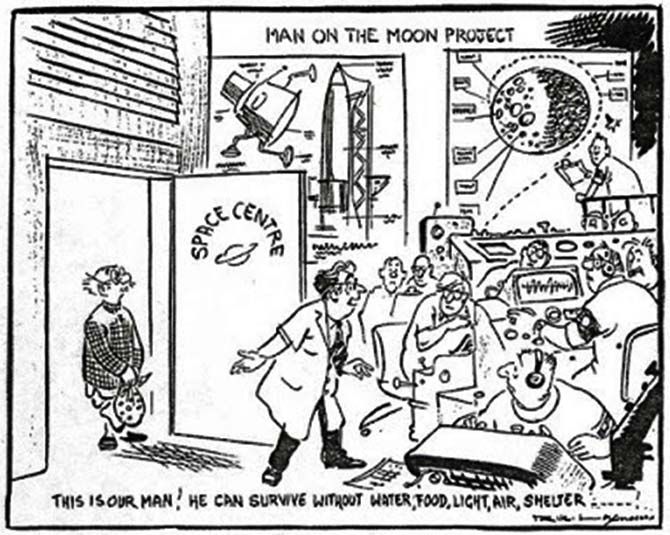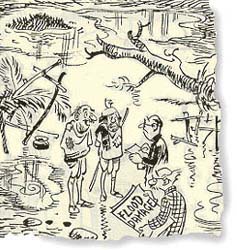'Laxman will be remembered for years to come as the person whom everybody turned to the first thing in the morning and drew a smile, however depressing the situation. It will be impossible to replace him...'
Darryl D'Monte recalls his long association with R K Laxman.
 I still recall one of R K Laxman's most brilliant cartoons which dealt with the premiere of Richard Attenborough's Gandhi in India. Several politicians donning Gandhi caps are walking out of the theatre and one confides to another: 'I'm told it's based on a true-life account!'
I still recall one of R K Laxman's most brilliant cartoons which dealt with the premiere of Richard Attenborough's Gandhi in India. Several politicians donning Gandhi caps are walking out of the theatre and one confides to another: 'I'm told it's based on a true-life account!'
On an earlier occasion, as editor of the Sunday magazine of The Times of India in the 1970s, I took an article on the ceiling on rural land holdings to Laxman to illustrate. He was reluctant to put his pen to paper on such a mundane subject. However, I cajoled him to do it and he eventually succumbed.
He did a half page illustration for the tabloid, as the Times Weekly was then called. It was of a concrete slab -- a literal ceiling -- being lowered on an emaciated farmer, who is discomfited by the impending imposition.
One could not persist with the great cartoonist, but he must have seen the less-than-enthusiastic look on my face.
"Hang on a moment," he said, and retrieved the illustration. With a few deft strokes of the pen, he drew -- once again -- a Gandhi-capped politician, atop the slab, cocking a snook at the beleaguered farmer.
It converted a pedestrian drawing to an inspired one, such was his genius.
All will recall his long stint at the ToI and his pocket cartoon, with the iconic common man. In many ways, although the newspaper allotted him pride of place with a three-column cartoon on the front page, he was at his acerbic best with the smaller format, where his nose singled out the travails of the ordinary person -- whom Gandhiji called 'The last man.' He was portrayed with such innocuous, but incisive humour.
Few may remember that Laxman drew much of his inspiration from the equally legendary British cartoonist, Sir David Low. In its obituary of Laxman, the online India edition of the Daily Mail in the United Kingdom wrote: 'Inclined towards drawing since childhood, Laxman was influenced by the illustrations in magazines such as Punch, Tit-Bits, Strand and Bystander, and by world-renowned British cartoonist Sir David Low.' If I correctly recall him telling me, the ToI sent him to London in the 1950s where he spent a few months working with Low.
Perhaps it was difficult for Laxman to escape from the uncertainties of that earlier era, where politicians and politics were more black and white, all the more so in the UK where the Second World War almost brought the country to its knees under a German dictator.
His drawings were redolent of those symbols -- a train going off its tracks, an elephant lumbering along and being overtaken by a car, people hurtling towards a cliff, a fish out of water and so on. His were, ala Low, bold brushstrokes and his figures were not the willowy outlines which many of his predecessors and successors in India adopted.
One such, whose work may easily be mistaken for Laxman's, was none other than Bal Thackeray. Apocryphal legend has it that the two cartoonists worked together at the Free Press Journal, but Laxman's moving on to much greener pastures at the ToI annoyed Thackeray sufficiently enough to form the Shiv Sena! Certainly, the latter's first attack was against south Indians, whom he blamed for taking away jobs in amchi Mumbai. Raj Thackeray has emulated the same style.
Driving his perennial black Ambassador, and eschewing drivers, Laxman would turn up the first among his senior editorial colleagues at the office around 8.30 am.
He was then ensconced with all the day's newspapers before attending the morning conference at 10 am, presided over by such stalwarts as Frank Moraes, S Nanporia and Sham Lal.
He would then remain incommunicado, turning down the opportunity to eat at the executives' lunch room in favour of his own, frugal vegetarian repast.
By mid-afternoon, in those days before faxes and e-mail, he had to finish by mid-afternoon the three-column illustration three times a week, and possibly a fourth on Sunday, which had several small cartoons encompassed in one. In addition, he had to send his weekday pocket cartoon, all of which had to be airlifted to Delhi to catch the next morning edition.
After that, and precisely at a time when assistant editors were battling with their ponderous editorials, he was in a playful mood and would visit each of his senior colleagues, anxious to gossip and crack jokes.
His contemporaries would have to humour him, for fear of offending the great man, but it was often at the cost of their prose in the 300-word edits which had to run the gauntlet of the editor that afternoon.
He had nicknames for senior colleagues and, when I rejoined the ToI as its resident editor in the late 1980s, I lived in dread of what mine was, but never found out.
Laxman, for all his greatness, was a very private person and intolerant of other cartoonists, none of whom he encouraged to draw in his paper. Mario Miranda was a colleague, though more of an illustrator than cartoonist, in the Illustrated Weekly.
Though Mario lacked political sense, he was barred from gracing the daily newspaper even on social issues. He had to graduate to the Economic Times for his gentle daily pocket take on suited and booted portly executives and their sexy secretaries.
As junior assistant editors in the 1970s, we would often play a prank on Laxman by praising one of Abu's cartoons in the Indian Express. His face would cloud over with disagreement. Abu Abraham began his career as a journalist with the fearless Bombay Chronicle and later reinvented himself as a cartoonist in Shankar's Weekly before going to London where he worked with The Observer and Guardian and returned to draw for the Indian Express in the late 1960s.
Laxman also illustrated magazines and even books, including travelogues profusely. He was a workaholic. With an unerring sense of fusion, he illustrated his brother R K Narayan's stories in the Illustrated Weekly. His commercial work was also equally productive, including the loveable character, the unkempt boy Gattu, for Asian Paints.
Laxman will be remembered for years to come as the person whom everybody turned to the first thing in the morning and drew a smile, however depressing the situation. It will be impossible to replace him, though newspapers seem to have dropped cartoons for the most part, and certainly on the front page.
Darryl D'Monte worked as an assistant editor at The Times of India from 1969 to 1979 and then as resident editor in Mumbai from 1988 to 1994.










